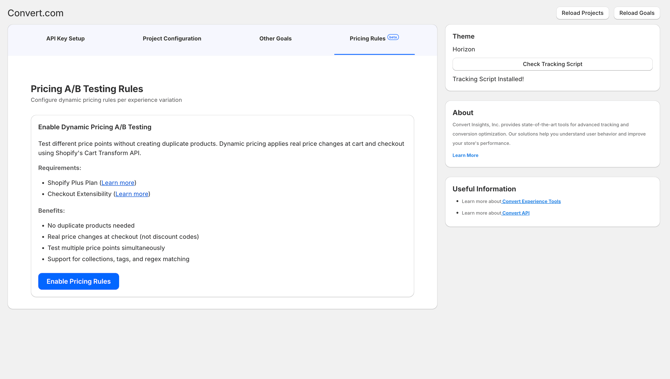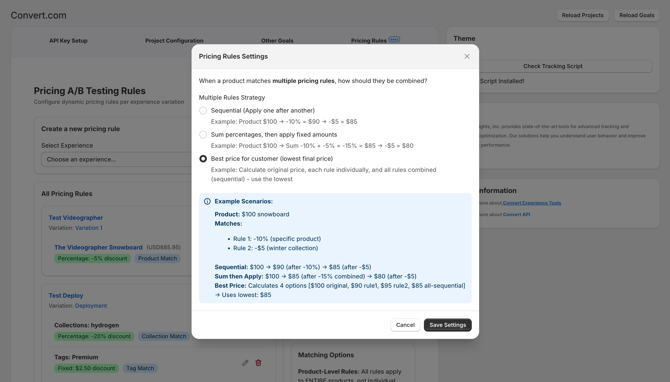Shopify Pricing A/B Testing - Managing Multiple Rules & Combinations
Stack and combine Shopify pricing rules—sequential, sum-then-apply, or best-price—for consistent, no-code price tests across your store.
THIS ARTICLE HELPS YOU:
- Understand Multiple Rules
- Know how the Rules Combine
- Choose Combination Strategy
- Get some Real-world Examples
- Dual Identifier System
- Smart Matching Behaviour
- Understand Limitation
- Troubleshoot
- Get some Best Practices
| Author: | Ahmed Abbas |
Overview
This guide explains how to work with multiple pricing rules and understand how they combine when a product matches more than one rule.
Multiple Rules Per Product
A product can match multiple pricing rules at once!
Example: A product that's:
-
In "Summer Sale" collection (gets -10%)
-
Has "VIP" tag (gets -$5 off)
-
Both rules apply!
Four Matching Types Explained
1. Specific Product (Exact Match)
Best for: Testing individual products
How it works:
-
Search by product name, SKU, or handle
-
Select the exact product you want to test
-
Rule applies to that product only
Example:
-
Product: "Awesome Cotton T-Shirt"
-
Rule: -10%
-
Result: Only this product gets the discount
2. Regex Pattern
Best for: Matching multiple products with similar names/handles
How it works:
-
Enter a pattern that matches product handles or IDs
-
Any product matching the pattern gets the rule
Common Patterns:
|
Pattern
|
Matches
|
Example Products
|
^SHIRT-.* |
All handles starting with "SHIRT-"
|
SHIRT-001, SHIRT-RED, SHIRT-BLUE
|
.*premium.* |
All handles containing "premium"
|
premium-tshirt, the-premium-pack
|
^721.* |
All product IDs starting with 721
|
7211234, 7215678
|
PREMIUM-\d+ |
"PREMIUM-" followed by numbers
|
PREMIUM-100, PREMIUM-999
|
Tips:
-
Test your regex pattern on a regex tester first
-
Use
.*to match any characters -
Use
^for "starts with",$for "ends with" -
Regex is case-sensitive by default
3. Collections/Categories
Best for: Testing all products in a category
How it works:
-
Select one or more collections from the dropdown
-
All products in those collections automatically match
Example:
-
Collection: "Summer Sale"
-
Rule: -15%
-
Result: All 50 products in "Summer Sale" get 15% off
Special Collection:
-
"All Products" - Matches every product in your store
-
Useful for store-wide pricing tests
4. Product Tags
Best for: Testing products with specific attributes
How it works:
-
Select one or more tags from the dropdown
-
All products with those tags automatically match
Example:
-
Tag: "VIP"
-
Rule: -$10 off
-
Result: All products tagged "VIP" get $10 off
Common Use Cases:
-
VIP products
-
Clearance items
-
Seasonal products
-
Featured items
How Multiple Rules Combine
When a product matches multiple rules (e.g., it's in a collection AND has a tag), you need to choose how those rules combine.
Strategy 1: Sequential Application (Default)
Rules are applied one after another in order.
Example:
-
Original price: $100
-
Rule 1: -10% (collection rule)
-
Rule 2: -$5 (tag rule)
Calculation:
$100 → apply -10% = $90 → apply -$5 = $85
Final Price: $85
Best for:
-
Traditional discount stacking
-
When you want each rule to compound on the previous result
-
Most intuitive for customers
Strategy 2: Sum Percentages, Then Apply Fixed
Sum all percentage discounts first, then apply fixed amounts.
Example:
-
Original price: $100
-
Rule 1: -10% (collection rule)
-
Rule 2: -5% (tag rule)
-
Rule 3: -$5 (another tag rule)
Calculation:
Sum percentages: -10% + -5% = -15%
$100 → apply -15% = $85 → apply -$5 = $80
Final Price: $80
Best for:
-
When you have multiple percentage-based rules
-
More aggressive discounting
-
Simplifying complex discount math
Strategy 3: Best Price for Customer
Calculate multiple price options and use the lowest price.
What gets calculated:
-
Original price: $100
-
Rule 1 only: $90 (-10%)
-
Rule 2 only: $95 (-$5)
-
All rules combined (sequential): $85
Result: Uses $85 (the lowest)
Important: The system does NOT calculate sum-then-apply combinations - only sequential.
Best for:
-
Ensuring customers always get the best deal
-
Complex discount scenarios
-
Building customer trust
Example Comparison:
|
Price Option
|
Calculation
|
Result
|
|
Original
|
$100
|
$100
|
|
Rule 1 only
|
$100 - 10%
|
$90
|
|
Rule 2 only
|
$100 - $5
|
$95
|
|
Sequential
|
($100 - 10%) - $5
|
$85
|
Final price: $85 (lowest)
How to Choose Combination Strategy
Via App UI
-
Go to Shopify Admin → Apps → Convert → Pricing Rules

-
Select your Experience and Variation
-
Add your rules
-
Click the "Settings" button (next to "Save All Rules")
-
Choose your preferred strategy:
-
Sequential Application
-
Sum Percentages, Then Apply Fixed
-
Best Price for Customer
-
-
Click "Save Settings"

Real-World Examples
Example 1: VIP Sale
Goal: Give extra discount to VIP customers during a sale
Setup:
-
Rule 1: Collection "Summer Sale" → -15%
-
Rule 2: Tag "VIP" → -$10 off
-
Strategy: Sequential
Results:
-
Regular customer (no VIP tag): $100 → $85 (15% off)
-
VIP customer: $100 → $85 → $75 (15% off + $10)
Example 2: Multi-Tag Discounts
Goal: Stack discounts for products with multiple tags
Setup:
-
Rule 1: Tag "Clearance" → -20%
-
Rule 2: Tag "Last-Chance" → -10%
-
Rule 3: Tag "Bulk-Eligible" → -5%
-
Strategy: Sum Percentages
Results:
-
Product with all 3 tags: $100 → $65 (combined -35% off)
-
Product with 2 tags: $100 → $70 (combined -30% off)
Example 3: Best Price Guarantee
Goal: Ensure customers always get the best deal
Setup:
-
Rule 1: Collection "Winter Sale" → -25%
-
Rule 2: Tag "Member" → -$15 off
-
Strategy: Best Price for Customer
Results for $100 product:
|
Option
|
Price
|
|
Original
|
$100
|
|
Winter Sale only
|
$75
|
|
Member discount only
|
$85
|
|
Both (sequential)
|
$60
|
Customer pays: $60 (best price)
Dual Identifier System
When you configure rules via the UI, the system automatically stores multiple identifiers for each product:
What Gets Stored
-
Variant ID - Most reliable for cart/checkout
-
Product ID - Product-level matching
-
SKU - Used on product pages (if available)
-
Handle - Used on collection, search, and other pages
-
Collections - Automatic matching for collection-based rules
-
Tags - Automatic matching for tag-based rules
Why This Matters
Different pages use different identifiers:
|
Page Type
|
Primary Identifier
|
|
Product pages
|
Variant ID, Product ID, SKU
|
|
Collection pages
|
Handle, Collections, Tags
|
|
Search pages
|
Handle
|
|
Cart/Checkout
|
Variant ID
|
With multiple identifiers:
-
 Configure once, works everywhere
Configure once, works everywhere -
 Consistent pricing across your entire store
Consistent pricing across your entire store -
 No need to configure separately for each page type
No need to configure separately for each page type
Smart Matching Behavior
When you configure multiple rules for a variation, the system uses "smart matching" to ensure consistent pricing:
How it works:
-
If a product's handle matches ANY rule → ALL rules from that variation apply to that product
-
This ensures the same product gets the same price everywhere
Example:
Rules configured:
-
Product handle "the-snowboard" → -15%
-
Collection "Summer" → -5%
-
Tag "Sale" → -2%
Result:
-
Product "the-snowboard": Gets ALL 3 discounts everywhere

-
Product page: $100 → $78.30
-
Collection page: $100 → $78.30
-
Checkout: $100 → $78.30
-
-
Other products in "Summer" collection (not "the-snowboard"): Get only collection + tag discounts
-
If also has "Sale" tag: $100 → $93.10 (-5% then -2%)
-
Benefits:
-
 Consistent pricing across all pages
Consistent pricing across all pages -
 No customer confusion
No customer confusion -
 Predictable behavior
Predictable behavior
Important Limitations
Collection Page Product Limits
Limitation: First 50 products on collection pages are pre-populated with full data (Shopify Liquid limit)
Impact:
-
Products 1-50: All rules work (handle, collections, tags, regex)
-
Products 51+: Only handle-based rules work
Workaround: Most common use case (first 50 products) works perfectly
Product Page Related Products
Limitation: Main product + up to 10 related products from recommendations API
Impact:
-
Main product: All rules work
-
Related products: Only handle-based rules work
Note: This rarely affects customer experience as customers focus on the main product
Home & Search Pages
Limitation: Collection and tag data NOT available (Shopify Liquid limitation)
Impact:
-
Handle-based rules:
 Work
Work -
"All Products" collection:
 Works
Works -
Specific collection rules:
 Don't work
Don't work -
Tag rules:
 Don't work
Don't work
Recommendation: For rules that must work on ALL pages, use:
-
Handle-based matching (specific products or regex patterns)
-
"All Products" collection
Troubleshooting Multiple Rules
Problem: Multiple rules not applying correctly
Solution:
-
Click "Settings" button in the app UI
-
Try different combination strategies:
-
Sequential (default) - Rules applied in order
-
Sum then Apply - Percentages combined
-
Best Price - Lowest price wins
-
-
Save and test again
Debug:
-
Open browser console (F12)
-
Look for:
 Total rules matched: X
Total rules matched: X -
Look for:
 Strategy: [strategy name]
Strategy: [strategy name] -
Look for:
 Final price: X → Y
Final price: X → Y
Problem: Some products not matching collection/tag rules
Check these:
-
Page Type:
-
Are you testing on home/search pages? (Collection/tag rules don't work there)
-
Try testing on product page or collection page
-
-
Product Position:
-
Is the product beyond position 50 on a collection page? (Limitation)
-
-
Collection/Tag Assignment:
-
Verify in Shopify Admin that the product is actually in the collection
-
Verify the product has the tag you're matching
-
Problem: Rules applying inconsistently across pages
This usually means:
-
Using collection or tag rules on pages where they're not supported
Solution:
-
Use handle-based rules for consistency across ALL pages
-
Or accept that collection/tag rules only work on product/collection/checkout pages
Best Practices
1. Start Simple
-
Begin with a single rule per variation
-
Test thoroughly
-
Add complexity gradually
2. Use Handle-Based for Universal Coverage
-
If rules must work everywhere (home, search, product, checkout)
-
Use specific product selection or regex patterns on handles
3. Use Collections/Tags for Category-Wide Tests
-
Perfect for product and collection pages
-
Easier to manage than individual products
-
Just remember they don't work on home/search pages
4. Test Your Strategy
-
Try all three combination strategies with sample products
-
Choose the one that makes sense for your business
-
Document your choice for future reference
5. Monitor Debug Console
-
Keep browser console open during initial testing
-
Look for pricing calculation logs
-
Verify rules are matching as expected
Need Help?
Still confused about rule combinations? Contact Convert support with:
-
Your Experience ID
-
List of rules you're trying to configure
-
Expected vs actual behavior
-
Screenshots of your configuration
Our team can help you choose the right strategy and troubleshoot any issues.